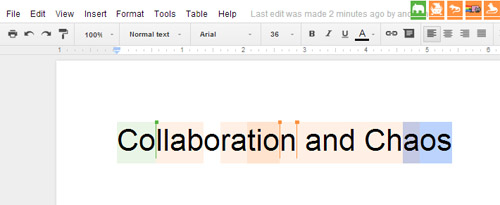
Image Credit:
Cole Wehrle
As long as I’ve had the pleasure of teaching in one of the DWRL class rooms I’ve flirted with the idea of using Google Docs in a classroom setting. In-class writing assignments are certainly nothing new, but Google Docs made it possible to transform what was a space for quiet reflection into one that demanded open collaboration.
At least, it was theoretically possible. While useful for all kinds of list-making and brainstorming, the promise of Google Docs, as a productive space for real-time collaboration seems largely illusory. As anyone who has ever tried to write a CFP at the same time knows, what results is mostly frustration and confusion. It might be easier to have everyone shouting over a laptop.
So I tabled the idea until, a few weeks ago, I found myself reading about the idea of the “flipped-classroom,” which had become the pedagogical-tactic-of-the-month and was generating lots of buzz on various blogs and op-ed pages. For those who missed the wave (or have yet to catch it), the idea is simple and counterintuitive. Teachers, usually working in small groups, record all of the classroom lectures and send them to students so they can stream them at home. Then, when the students come to class the next day, the teacher will help them with their homework. This has been applied to subjects as diverse as algebra and American history, and many teachers are finding that the “flipped-classroom” has allowed them to tailor their class to the needs of individual students without sacrificing content.
I was intrigued by the concept but was unsure how to apply it to a writing class. When I was a journalism student we routinely had to produce short articles in the space of a 75 minute lab class, but it was a demanding experience and seemed unfair to give it to students in a basic writing class. About that time I realized that Google Docs might provide the answer. If it was too much to ask a single student to produce a research summary in a 75 minute class, perhaps it was somewhat more reasonable to ask it of a group.
Before the class I asked my students to look over two sample research summaries, one very good and the other very bad. Then, during the next class period we began by coming up with two lists of what qualities made the good research summary good and the bad example bad. I then played a short video, passed out a transcript, and asked each group of 3-4 students to produce a good research summary using Google Docs on that video. After a few minutes, when they had set everything up, I casually mentioned that they had to turn it in by the end of class. No late assignments would be accepted.
Panic ensued, complaints were levied, but, after they realized that this was not a point for compromise, they began dividing the work and approaching their job systematically. The activity had forced them all into the 11th hour crunch, but this time both their classmates and I were on-hand to help. Over the next 45 minutes the students bombarded me with concise, earnest questions about phrasing and grammar while helping each other frame and format their citations. By the end of the class every single group had produced a finished research summary and it was likely the best batch of short papers I’ve ever received.
I’m not sure how to apply the activity to a longer paper, but it certainly seems like an avenue worth exploring.

